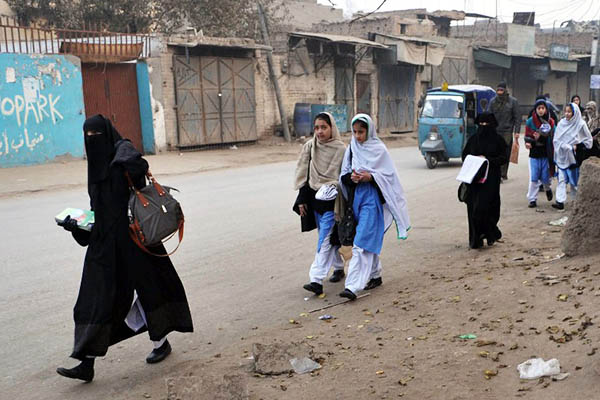
File Photo. Hasham Ahmed—AFP
In his latest “revealing” column for daily Dawn, former finance minister Miftah Ismail has written on education in Pakistan, saying: “The federal and provincial governments together spend about Rs. 1,000 billion on education annually. That’s almost twice the cost of running the civilian federal government and by far the biggest item after defense and debt-servicing. And that’s just public-sector spending. Private spending is more than this number. Unfortunately, 75 years after independence, almost four in 10 Pakistanis remain illiterate, consigned to a life of hardship and poverty. Worse still, the literacy rate isn’t even improving. In 2020, our net enrolment rate in primary schools was only 64 percent—down from 67 percent in 2015. Punjab and Balochistan maintained their ratios at 70 percent and 56 percent, respectively. Yet Sindh’s net enrolment actually went down from 61 percent to 55 percent and KP’s ratio (even excluding the former tribal agencies) went down from 71 percent to 66 percent. Half of all school-age children are not in school.”
The first question that arises is: who in Pakistan is even thinking of education? From medieval to modern, we have had all sorts of ”educational minds,” but all of them end up doing nothing. After coming into power in 2018, Imran Khan decided on the “unification” of the three “systems” of education—Urdu-medium, English-medium, madrassas—going about it by predictably imposing the “madrassa” on the other two streams. Lawmakers in Punjab even went so far as to threaten publishers with jail if they didn’t secure government approval before printing or importing any “objectionable” written works. Since education is a provincial subject, Punjab and Khyber-Pakhtunkhwa—both led by the PTI—bore the brunt of this “reform.”
The basic problem with education in present-day Pakistan is its reluctance to impart “analytical and critical” thinking. Pakistani educationists fear the “critical” trait of the human mind and their textbooks aim to prevent students from applying a “critical” yardstick while analyzing “ideology.” Pakistan is not alone in Islamic states to have an educational system hostile to “free knowledge”; the Arab world is equally crippled with Iran and Turkey, despite having sound educational traditions, also having succumbed to Islamism and its anti-knowledge worldview. As posited by Arab News in 2017, “the central discord is magnified by the quality of teaching across the region as methods remain tied to didactic learning with a diminished insistence on analytical and critical thinking.”
Another negative factor in the Muslim world is the frequent incidence of war that upsets the intellectual conditions required for education, replacing it with “propaganda.” The rise of Islamism further damages the edifice of rational learning. Despite Ismail’s claims, Pakistan has little money left over to fund education after “fighting” or “preparing” for wars. Teachers, too, are a problem. Most primary school teachers in Pakistan are madrassa graduates who are ill-equipped for secular teaching, with children studying in state-funded schools lacking in math and history as fact-based narrative. In other words, the state sector education mostly relies on brainwash as teaching methodology. Unfortunately, looking for good teachers will remain a problem where war and high birthrate outstrips the capacity of the state to produce good teachers capable of imparting “modern knowledge.”
